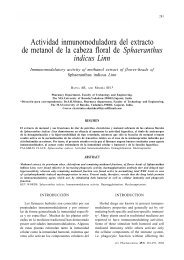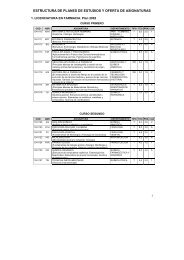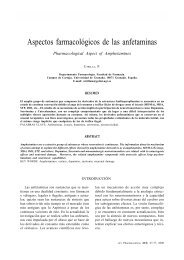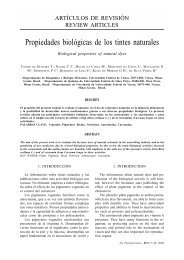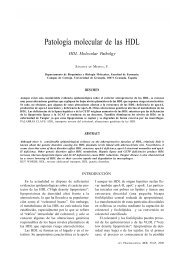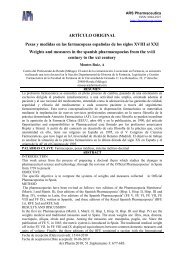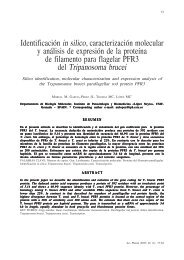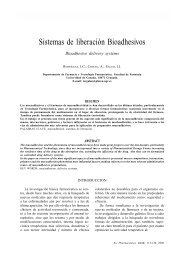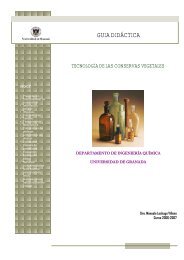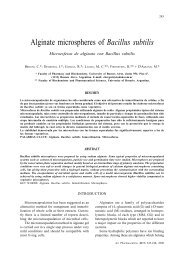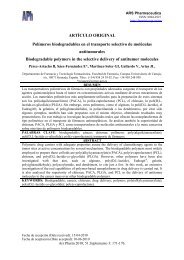Prevalencia del consumo de cigarrillos en adolescentes de la ...
Prevalencia del consumo de cigarrillos en adolescentes de la ...
Prevalencia del consumo de cigarrillos en adolescentes de la ...
You also want an ePaper? Increase the reach of your titles
YUMPU automatically turns print PDFs into web optimized ePapers that Google loves.
PREVALENCIA DEL CONSUMO DE CIGARRILLOS EN ADOLESCENTES DE LA CIUDAD DE CÓRDOBA, ARGENTINA<br />
THE PREVALENCE OF ADOLESCENT SMOKING IN THE CITY OF CORDOBA, ARGENTINA<br />
<strong>Preval<strong>en</strong>cia</strong> <strong><strong>de</strong>l</strong> <strong>consumo</strong> <strong>de</strong> <strong>cigarrillos</strong><br />
<strong>en</strong> adolesc<strong>en</strong>tes <strong>de</strong> <strong>la</strong> ciudad <strong>de</strong> Córdoba,<br />
Arg<strong>en</strong>tina<br />
The preval<strong>en</strong>ce of adolesc<strong>en</strong>t smoking in the city of Cordoba, Arg<strong>en</strong>tina<br />
BIRRI M, CABRAL PÉREZ M, AGNESE A<br />
Cátedra <strong>de</strong> Salud Pública. Departam<strong>en</strong>to <strong>de</strong> Farmacia. Facultad <strong>de</strong> Ci<strong>en</strong>cias Químicas. Universidad Nacional<br />
<strong>de</strong> Córdoba. Edifi cio <strong>de</strong> Ci<strong>en</strong>cias 2 - Ciudad Universitaria (CP 5000) – Córdoba - Arg<strong>en</strong>tina<br />
e-mail: magnese@fcq.unc.edu.ar<br />
RESUMEN<br />
Es conocido que el tabaco es <strong>la</strong> más importante causa prev<strong>en</strong>ible <strong>de</strong> muerte prematura <strong>en</strong> muchos países. Reconoci<strong>en</strong>do<br />
al tabaquismo como tema prioritario <strong>en</strong> salud pública, se realizó un diagnóstico <strong>de</strong> situación sobre el<br />
<strong>consumo</strong> <strong>de</strong> <strong>cigarrillos</strong> <strong>en</strong>tre los adolesc<strong>en</strong>tes, <strong>de</strong> seis escue<strong>la</strong>s, <strong>de</strong> <strong>la</strong> ciudad <strong>de</strong> Córdoba, Arg<strong>en</strong>tina, a los fi nes <strong>de</strong><br />
<strong>de</strong>terminar su <strong>Preval<strong>en</strong>cia</strong>. Utilizando como instrum<strong>en</strong>to una <strong>en</strong>cuesta adaptada <strong>de</strong> <strong>la</strong> Organización Mundial <strong>de</strong> <strong>la</strong><br />
Salud (OMS) y procesando los datos mediante el programa Epi-Info versión 3.3 se <strong>de</strong>mostró, <strong>en</strong>tre otros, que <strong>la</strong><br />
<strong>Preval<strong>en</strong>cia</strong> <strong><strong>de</strong>l</strong> hábito tabáquico es <strong>de</strong> 30,45% (IC 95%= 27,50% – 33,50%) y que el 56,80% (IC 95%= 53,60%<br />
- 60,00%) <strong>de</strong> los adolesc<strong>en</strong>tes han probado el cigarrillo aunque sea una vez <strong>en</strong> su vida.<br />
PALABRAS CLAVES: Adolesc<strong>en</strong>tes. Córdoba. <strong>Preval<strong>en</strong>cia</strong>. Tabaco.<br />
ABSTRACT<br />
It is a well established fact that in many countries smoking is a major cause of prev<strong>en</strong>table <strong>de</strong>ath. In recognition of<br />
smoking as a priority topic in public health policy, a diagnosis of smoking habits among adolesc<strong>en</strong>ts from six secondary<br />
schools was carried out in the city of Cordoba, Arg<strong>en</strong>tina, in or<strong>de</strong>r to <strong>de</strong>termine its preval<strong>en</strong>ce. An adapted form<br />
of a World Health Organisation (WHO) questionnaire was used as a survey instrum<strong>en</strong>t and the gathered data was<br />
processed using the Epi-Info program, version 3.3. The results obtained <strong>de</strong>monstrated, among other consi<strong>de</strong>rations, that<br />
the preval<strong>en</strong>ce of smoking among this popu<strong>la</strong>tion group was 30.45% (IC 95%= 27.50% – 33.50%) and that 56.80% (IC<br />
95%= 53.60% - 60.00%) had smoked a cigarette at least once in their lives.<br />
KEY WORDS: Adolesc<strong>en</strong>ts. Cordoba. Preval<strong>en</strong>ce. Tobacco.<br />
Fecha <strong>de</strong> recepción: 29-09-06<br />
Fecha <strong>de</strong> aceptación: 19-04-07<br />
INTRODUCCIÓN<br />
Cada año el tabaco es el responsable <strong>de</strong> <strong>la</strong><br />
muerte <strong>de</strong> 3,5 millones <strong>de</strong> personas, o expresado<br />
<strong>de</strong> otro modo, <strong>de</strong> una muerte cada 9 segundos 1 .<br />
En <strong>la</strong> Arg<strong>en</strong>tina <strong>la</strong> epi<strong>de</strong>mia <strong><strong>de</strong>l</strong> tabaquismo mata<br />
a 40.000 arg<strong>en</strong>tinos por año 2 . La Organización<br />
Mundial <strong>de</strong> <strong>la</strong> Salud (OMS) estima que hay mil<br />
millones <strong>de</strong> fumadores <strong>en</strong> el mundo, y que <strong>de</strong><br />
TRABAJOS ORIGINALES<br />
ORIGINALS WORKS<br />
INTRODUCTION<br />
121<br />
Every year, tobacco consumption is responsible<br />
for the <strong>de</strong>ath of 3.5 million people, or otherwise<br />
expressed, one <strong>de</strong>ath every 9 seconds 1 . In Arg<strong>en</strong>tina<br />
the smoking epi<strong>de</strong>mic kills 40,000 per<br />
year 2 . The World Health Organisation (WHO)<br />
estimates that there are a total of a thousand million<br />
smokers worldwi<strong>de</strong> and that 500 million of<br />
Ars Pharm 2007; 48 (2): 121-134.
122<br />
ellos, 500 millones (el equival<strong>en</strong>te a 10 veces el<br />
total <strong>de</strong> muertos <strong>en</strong> <strong>la</strong> segunda guerra mundial)<br />
serán “matados” por el tabaco si los patrones <strong>de</strong><br />
vida (hábito <strong>de</strong> fumar) continúan 3 .<br />
En el humo <strong><strong>de</strong>l</strong> tabaco, al que están expuestos<br />
fumadores activos y pasivos, exist<strong>en</strong> más <strong>de</strong> 4000<br />
constituy<strong>en</strong>tes, <strong>en</strong>tre los que se incluy<strong>en</strong> 43 carcinóg<strong>en</strong>os<br />
conocidos (por ejemplo: arsénico, cadmio,<br />
polonio, hidrocarburos aromáticos policiclicos,<br />
etc) 4 , a<strong>de</strong>más <strong>de</strong> los ya conocidos: monóxido <strong>de</strong><br />
carbono, nicotina y alquitrán. Es bi<strong>en</strong> sabido que<br />
<strong>la</strong> nicotina crea <strong>de</strong>p<strong>en</strong><strong>de</strong>ncia al tabaco, eleva <strong>la</strong><br />
t<strong>en</strong>sión arterial y el ritmo cardíaco; el monóxido<br />
<strong>de</strong> carbono combinado con <strong>la</strong> nicotina, predispone<br />
al fumador a trombosis coronaria y <strong>en</strong>fermeda<strong>de</strong>s<br />
cardiovascu<strong>la</strong>res; el alquitrán es un ag<strong>en</strong>te carcinóg<strong>en</strong>o<br />
que, junto a otras sustancias nocivas <strong><strong>de</strong>l</strong><br />
humo <strong><strong>de</strong>l</strong> tabaco, pue<strong>de</strong> producir cáncer 3 .<br />
Muchos estudios han <strong>de</strong>mostrado que el tabaco<br />
increm<strong>en</strong>ta el riesgo <strong>de</strong> muerte prematura<br />
por <strong>en</strong>fermeda<strong>de</strong>s crónicas, <strong>en</strong>tre el<strong>la</strong>s afecciones<br />
coronarias cardíacas, infarto, bronquitis crónica,<br />
<strong>en</strong>fisema y cáncer <strong>de</strong> pulmón, <strong>la</strong>ringe, boca,<br />
esófago, faringe, páncreas y vejiga. 4<br />
Otras condiciones <strong>de</strong> salud adversas adicionales<br />
incluy<strong>en</strong>: afecciones respiratorias, ulcera<br />
péptica, complicaciones <strong>en</strong> el embarazo, y otras,<br />
que son causadas y/o exacerbadas por el tabaco.<br />
Por ejemplo los efectos adversos <strong><strong>de</strong>l</strong> tabaco <strong>en</strong> el<br />
embarazo abarcan <strong>de</strong>s<strong>de</strong> bajo peso al nacer (uno <strong>de</strong><br />
los predictores más fuertes <strong>de</strong> mortalidad infantil)<br />
a un aum<strong>en</strong>to <strong>de</strong> <strong>la</strong> inci<strong>de</strong>ncia <strong>de</strong> aborto espontáneo,<br />
partos prematuros y síndrome <strong>de</strong> muerte<br />
súbita infantil. 4 La OMS afirma a<strong>de</strong>más que el<br />
tabaco asociado a <strong>la</strong> pobreza g<strong>en</strong>era problemas<br />
<strong>de</strong> malnutrición y muerte prematura. 5<br />
Por otra parte <strong>la</strong> exposición al humo <strong><strong>de</strong>l</strong> tabaco<br />
es causa <strong>de</strong> <strong>en</strong>fermeda<strong>de</strong>s, incluy<strong>en</strong>do cáncer<br />
<strong>de</strong> pulmón <strong>en</strong> no fumadores. Los niños cuyos<br />
padres fuman ti<strong>en</strong><strong>en</strong> un mayor riesgo <strong>de</strong> sufrir<br />
infecciones <strong><strong>de</strong>l</strong> tracto respiratorio inferior (tales<br />
como bronquitis y neumonía) que los niños <strong>de</strong><br />
padres no fumadores. La inci<strong>de</strong>ncia y severidad<br />
<strong><strong>de</strong>l</strong> asma <strong>en</strong> niños es también agravada <strong>en</strong>tre los<br />
fumadores pasivos.<br />
También se han <strong>de</strong>tectado problemas <strong>en</strong> niños<br />
y adolesc<strong>en</strong>tes que fuman con trastornos <strong>de</strong> conducta<br />
(agresivas y tímidas), interpretadas a<strong>de</strong>más<br />
como conductas <strong>de</strong> riesgo sobre todo para el<br />
<strong>consumo</strong> ulterior <strong>de</strong> otras sustancias 6 , tomándose<br />
<strong>en</strong>tonces al tabaco como puerta <strong>de</strong> <strong>en</strong>trada para<br />
el <strong>consumo</strong> <strong>de</strong> otras drogas. 7,8<br />
Ars Pharm 2007; 48 (2): 121-134.<br />
BIRRI M, CABRAL PÉREZ M, AGNESE A<br />
such (the equival<strong>en</strong>t to 10 times the total number<br />
of <strong>de</strong>aths during the second world war) will die<br />
if pres<strong>en</strong>t smoking patterns continue 3 .<br />
Tobacco smoke, to which both active and<br />
passive smokers are exposed to, contains over<br />
4000 compon<strong>en</strong>ts, which inclu<strong>de</strong> 43 known<br />
carcinog<strong>en</strong>s (for example: Ars<strong>en</strong>ic, cadmium,<br />
polonium, polycyclic aromatic hydrocarbons,<br />
etc) 4 , in addition to those that have already<br />
be<strong>en</strong> i<strong>de</strong>ntified: carbon monoxi<strong>de</strong>, nicotine and<br />
tar. It is wi<strong><strong>de</strong>l</strong>y recognised that nicotine creates<br />
<strong>de</strong>p<strong>en</strong><strong>de</strong>ncy on tobacco, increases arterial<br />
t<strong>en</strong>sion and cardiac rhythm. Carbon monoxi<strong>de</strong><br />
combined with nicotine predisposes smokers to<br />
coronary thrombosis and cardiovascu<strong>la</strong>r disease.<br />
Tar is a carcinog<strong>en</strong>ic ag<strong>en</strong>t, which together with<br />
other harmful substances in tobacco smoke may<br />
cause cancer 3 .<br />
Many studies have <strong>de</strong>monstrated that smoking<br />
increases the risk of premature <strong>de</strong>ath through<br />
chronic diseases, such as coronary and cardiac<br />
disor<strong>de</strong>rs, heart attack, chronic bronchitis, and<br />
emphysema, as well as cancer of the lung, <strong>la</strong>rynx,<br />
mouth, oesophagus, pharynx, pancreas and<br />
b<strong>la</strong>d<strong>de</strong>r 4 .<br />
Other additional adverse health conditions<br />
inclu<strong>de</strong>: respiratory disor<strong>de</strong>rs, peptic ulcers, complications<br />
in pregnancy, and other conditions, that<br />
are caused and/or exacerbated by tobacco. For<br />
example, the adverse effects of tobacco during<br />
pregnancy range from low weight at birth (one<br />
of the strongest predictors of infant mortality)<br />
to an increase in the inci<strong>de</strong>nce of spontaneous<br />
miscarriage, premature birth and sud<strong>de</strong>n infant<br />
<strong>de</strong>ath syndrome 4 . Furthermore, the WHO c<strong>la</strong>ims<br />
that smoking associated with poverty g<strong>en</strong>erates<br />
problems of malnutrition and premature <strong>de</strong>ath 5 .<br />
On the other hand, exposure to tobacco smoke<br />
is also a cause of diseases, including lung cancer,<br />
in non-smokers. Childr<strong>en</strong> whose par<strong>en</strong>ts smoke are<br />
at higher risk of suffering lower respiratory tract<br />
infections, such as bronchitis and pneumonia, in<br />
comparison with childr<strong>en</strong> whose par<strong>en</strong>ts do not<br />
smoke. The inci<strong>de</strong>nce and severity of asthma in<br />
childr<strong>en</strong> as passive smokers is aggravated.<br />
Problems in childr<strong>en</strong> and adolesc<strong>en</strong>ts who<br />
smoke have also be<strong>en</strong> <strong>de</strong>tected in the form of<br />
behavioural disor<strong>de</strong>rs (aggressiv<strong>en</strong>ess and timidity).<br />
The risk of progressing onto the consumption<br />
of other substances has also be<strong>en</strong> <strong>de</strong>tected 6 , with<br />
tobacco being consi<strong>de</strong>red as the door of <strong>en</strong>try to<br />
the use of other drugs. 7,8
PREVALENCIA DEL CONSUMO DE CIGARRILLOS EN ADOLESCENTES DE LA CIUDAD DE CÓRDOBA, ARGENTINA<br />
THE PREVALENCE OF ADOLESCENT SMOKING IN THE CITY OF CORDOBA, ARGENTINA<br />
Todas estas afecciones son <strong>de</strong> elevadísimo<br />
costo llevándose su tratami<strong>en</strong>to una importante<br />
parte <strong>de</strong> los magros presupuestos <strong>en</strong> salud.<br />
Todos los expertos están <strong>de</strong> acuerdo <strong>en</strong> que<br />
el tabaquismo es el principal problema <strong>de</strong> salud<br />
pública susceptible <strong>de</strong> ser prev<strong>en</strong>ido 3,9 . Según<br />
estos antece<strong>de</strong>ntes <strong>la</strong> importancia <strong>de</strong> <strong>la</strong> lucha<br />
antitabáquica, los programas <strong>de</strong> prev<strong>en</strong>ción <strong><strong>de</strong>l</strong><br />
hábito <strong>de</strong> fumar y el apoyo a abandonar el hábito<br />
son <strong>de</strong> verda<strong>de</strong>ra relevancia. 10<br />
Es importante <strong>de</strong>stacar que <strong>la</strong> OMS calcu<strong>la</strong> que<br />
<strong>en</strong> 2030 el número <strong>de</strong> muertes anuales alcanzará<br />
a diez millones, 70 % <strong>de</strong> <strong>la</strong>s cuales ocurrirán <strong>en</strong><br />
países <strong>en</strong> vías <strong>de</strong> <strong>de</strong>sarrollo. Un aspecto a resaltar<br />
es que para evitar que <strong>la</strong>s muertes sucedan, se <strong>de</strong>be<br />
int<strong>en</strong>tar incidir <strong>en</strong>tre los adolesc<strong>en</strong>tes (principal<br />
etapa <strong>en</strong> don<strong>de</strong> se adquiere el hábito <strong>de</strong> fumar).<br />
La más importante meta es evitar el inicio.<br />
Parale<strong>la</strong>m<strong>en</strong>te el mo<strong><strong>de</strong>l</strong>o <strong>de</strong> globalización hace<br />
que crezcan mo<strong><strong>de</strong>l</strong>os <strong>de</strong> <strong>consumo</strong> que promocionan<br />
estilos <strong>de</strong> vida asociados al uso <strong><strong>de</strong>l</strong> cigarrillo.<br />
Coinci<strong>de</strong>ntem<strong>en</strong>te <strong>en</strong> los países <strong>de</strong>sarrol<strong>la</strong>dos <strong>la</strong><br />
exist<strong>en</strong>cia <strong>de</strong> fuertes campañas contra el uso <strong><strong>de</strong>l</strong><br />
tabaco impone restricciones que <strong>en</strong> países como<br />
Arg<strong>en</strong>tina, son mucho mas leves y reci<strong>en</strong>tes. De<br />
allí que para <strong>la</strong>s diversas compañías tabacaleras,<br />
Arg<strong>en</strong>tina sea un mercado sumam<strong>en</strong>te atractivo<br />
y promisorio. La industria <strong><strong>de</strong>l</strong> tabaco dirige sus<br />
principales esfuerzos publicitarios a los adolesc<strong>en</strong>tes<br />
puesto que ellos son sus nuevos cli<strong>en</strong>tes<br />
pot<strong>en</strong>ciales. 11<br />
La “Iniciativa Libre <strong>de</strong> Tabaco” <strong>de</strong> <strong>la</strong> OMS<br />
(TFI, por sus sig<strong>la</strong>s <strong>en</strong> ingles) ti<strong>en</strong>e como objetivo<br />
g<strong>en</strong>eral el co<strong>la</strong>borar para el <strong>de</strong>sarrollo <strong>de</strong><br />
una g<strong>en</strong>eración <strong>de</strong> niños y jóv<strong>en</strong>es no fumadores.<br />
Para esto <strong>de</strong>fine como tareas c<strong>en</strong>trales reunir toda<br />
<strong>la</strong> evi<strong>de</strong>ncia, coordinar el soporte técnico y crear<br />
<strong>la</strong>s alianzas estratégicas para investigar y exponer<br />
el impacto negativo <strong><strong>de</strong>l</strong> tabaco y como resultado,<br />
animar y darles sostén a niños y adolesc<strong>en</strong>tes <strong>en</strong><br />
llevar una vida libre <strong>de</strong> tabaco.<br />
De acuerdo a sus incumb<strong>en</strong>cias y a su formación<br />
académica, el Farmacéutico está facultado<br />
para <strong>de</strong>sarrol<strong>la</strong>r investigaciones epi<strong>de</strong>miológicas<br />
<strong>en</strong> diversos campos y áreas. Al mismo tiempo,<br />
por sus conocimi<strong>en</strong>tos y respaldado por <strong>la</strong> OMS<br />
<strong>en</strong> su informe sobre “El papel <strong><strong>de</strong>l</strong> farmacéutico<br />
<strong>en</strong> el sistema <strong>de</strong> at<strong>en</strong>ción <strong>de</strong> salud” 12 que hace<br />
refer<strong>en</strong>cia al importante rol <strong><strong>de</strong>l</strong> farmacéutico <strong>en</strong> <strong>la</strong>s<br />
acciones <strong>de</strong> prev<strong>en</strong>ción <strong>de</strong> <strong>la</strong> <strong>en</strong>fermedad, pue<strong>de</strong> y<br />
<strong>de</strong>be co<strong>la</strong>borar <strong>de</strong>sarrol<strong>la</strong>ndo diversas activida<strong>de</strong>s<br />
re<strong>la</strong>cionadas con <strong>la</strong> temática <strong><strong>de</strong>l</strong> Tabaquismo.<br />
123<br />
All of these health disor<strong>de</strong>rs lead to <strong>en</strong>ormous<br />
treatm<strong>en</strong>t costs, which account for a <strong>la</strong>rge part<br />
of meagre health budgets.<br />
All experts agree that smoking is curr<strong>en</strong>tly<br />
the most important prev<strong>en</strong>table public health<br />
problem 3,9 . In the light of all of these associated<br />
problems, the fight against smoking, smoking<br />
prev<strong>en</strong>tion programs and programs that support<br />
smokers in their fight to give up the habit are<br />
of great relevance 10 .<br />
The WHO has calcu<strong>la</strong>ted that by the year 2030,<br />
the number of smoking re<strong>la</strong>ted <strong>de</strong>aths will increase<br />
to as many as t<strong>en</strong> million people, of which 70%<br />
will occur in <strong>de</strong>veloping countries. An important<br />
relevant factor is that the key to the prev<strong>en</strong>tion<br />
of such <strong>de</strong>aths, lies in the prev<strong>en</strong>tion of smoking<br />
among adolesc<strong>en</strong>ts, who are at an age in which the<br />
smoking habit is most commonly acquired. The<br />
most important goal is to prev<strong>en</strong>t initiation.<br />
Paradoxically, smoking is portrayed on a global<br />
scale to be closely associated with attractive lifestyles.<br />
However, it is in the <strong>de</strong>veloping countries<br />
where the use of tobacco is ever increasingly<br />
being restricted, but in countries like Arg<strong>en</strong>tina,<br />
such restrictions are evi<strong>de</strong>ntly much less severe<br />
and more rec<strong>en</strong>t. For this reason it appears that<br />
for many tobacco companies, Arg<strong>en</strong>tina pres<strong>en</strong>ts<br />
a very attractive and promising market. The tobacco<br />
industry is directing its c<strong>en</strong>tral publicity<br />
effort towards adolesc<strong>en</strong>ts, who repres<strong>en</strong>t a great<br />
pot<strong>en</strong>tial as possible new cli<strong>en</strong>ts 11 .<br />
The WHO’s TFI, or Tobacco Free Initiative<br />
campaign, is focusing its effort on the objective<br />
of achieving a g<strong>en</strong>eration of non-smoking childr<strong>en</strong><br />
and adolesc<strong>en</strong>ts. In an attempt to achieve such<br />
an aim, it is focussing its effort on gathering<br />
all the evi<strong>de</strong>nce, technical support and relevant<br />
strategic alliances, to research and expose the<br />
negative impact on health of smoking, in the hope<br />
of <strong>en</strong>couraging and supporting young people in<br />
the objective of leading a life free from tobacco<br />
consumption.<br />
Pharmacists, due to their acquired social responsibility<br />
and aca<strong>de</strong>mic education, are capacitated to<br />
carry out epi<strong>de</strong>miological research in numerous<br />
fields. Their knowledge and support from the<br />
WHO which in a rec<strong>en</strong>t report titled “The role<br />
of the pharmacist in health care” 12 states that<br />
the pharmacists, who has an important role to<br />
p<strong>la</strong>y in the prev<strong>en</strong>tion of illness, can and must<br />
col<strong>la</strong>borate in activities aimed at the prev<strong>en</strong>tion<br />
of smoking.<br />
Ars Pharm 2007; 48 (2): 121-134.
124<br />
En acuerdo con <strong>la</strong>s leyes nacionales, provinciales<br />
y or<strong>de</strong>nanzas municipales vig<strong>en</strong>tes <strong>en</strong> <strong>la</strong><br />
Ciudad <strong>de</strong> Córdoba re<strong>la</strong>tivas al tabaco, 13-17 si<strong>en</strong>do<br />
este un tema prioritario a nivel <strong>de</strong> salud no<br />
sólo <strong>en</strong> Arg<strong>en</strong>tina sino mundialm<strong>en</strong>te, t<strong>en</strong>i<strong>en</strong>do<br />
<strong>en</strong> cu<strong>en</strong>ta <strong>la</strong>s recom<strong>en</strong>daciones <strong>de</strong> <strong>la</strong> OMS y<br />
at<strong>en</strong>to a su asamblea <strong>de</strong> mayo <strong>de</strong> 2003 18 nos<br />
propusimos llevar a cabo este estudio con <strong>la</strong><br />
finalidad <strong>de</strong> realizar un aporte al conocimi<strong>en</strong>to<br />
<strong>de</strong> <strong>la</strong> realidad local.<br />
Se propusieron como objetivos realizar un<br />
diagnóstico <strong>de</strong> situación <strong>de</strong> los adolesc<strong>en</strong>tes <strong>de</strong><br />
<strong>la</strong> ciudad <strong>de</strong> Córdoba <strong>en</strong> re<strong>la</strong>ción con el <strong>consumo</strong><br />
<strong>de</strong> <strong>cigarrillos</strong> y <strong>de</strong> esta forma <strong>de</strong>terminar<br />
<strong>la</strong> preval<strong>en</strong>cia <strong><strong>de</strong>l</strong> hábito <strong>en</strong> dicho grupo etario;<br />
procurar conocer qué proporción <strong>de</strong> <strong>la</strong> pob<strong>la</strong>ción<br />
bajo estudio está expuesta a un ambi<strong>en</strong>te <strong>de</strong><br />
riesgo y finalm<strong>en</strong>te conocer <strong>la</strong>s actitu<strong>de</strong>s, conocimi<strong>en</strong>tos<br />
y comportami<strong>en</strong>tos <strong>de</strong> los adolesc<strong>en</strong>tes<br />
re<strong>la</strong>cionados al <strong>consumo</strong> <strong>de</strong> <strong>cigarrillos</strong>.<br />
MATERIAL Y MÉTODOS<br />
El trabajo estuvo circunscripto a <strong>la</strong> ciudad <strong>de</strong><br />
Córdoba (pob<strong>la</strong>ción <strong>de</strong> refer<strong>en</strong>cia), provincia <strong>de</strong><br />
Córdoba, Arg<strong>en</strong>tina.<br />
La pob<strong>la</strong>ción elegible estuvo constituida por<br />
adolesc<strong>en</strong>tes <strong>en</strong> edad esco<strong>la</strong>r correspondi<strong>en</strong>tes al<br />
Ciclo Básico Unificado (CBU) y Ciclo <strong>de</strong> Especialización<br />
(<strong>en</strong>tre 11 y 18 años). Este estudio<br />
fue <strong>de</strong>sarrol<strong>la</strong>do <strong>en</strong> escue<strong>la</strong>s <strong><strong>de</strong>l</strong> área urbana <strong>de</strong><br />
<strong>la</strong> ciudad <strong>de</strong> Córdoba.<br />
Se empleó un diseño <strong>de</strong> muestra aleatoria <strong>de</strong><br />
<strong>la</strong> pob<strong>la</strong>ción <strong>de</strong> adolesc<strong>en</strong>tes don<strong>de</strong> <strong>la</strong>s unida<strong>de</strong>s<br />
<strong>de</strong> muestreo fueron <strong>la</strong>s escue<strong>la</strong>s, tanto públicas<br />
como privadas. Todas el<strong>la</strong>s t<strong>en</strong>ían <strong>la</strong> misma<br />
posibilidad <strong>de</strong> ser elegidas. Como <strong>la</strong> pob<strong>la</strong>ción<br />
elegible era prácticam<strong>en</strong>te inabordable, se realizó<br />
<strong>la</strong> selección <strong>de</strong> <strong>la</strong> pob<strong>la</strong>ción <strong>de</strong> estudio, o sea una<br />
muestra repres<strong>en</strong>tativa. De ahí que se eligieran<br />
escue<strong>la</strong>s <strong>de</strong> c<strong>la</strong>se social alta (CA), media (CM)<br />
y baja (CB).<br />
El procedimi<strong>en</strong>to seguido consistió <strong>en</strong> asignar<br />
un número a cada escue<strong>la</strong> y a continuación se<br />
fueron realizando sorteos <strong>en</strong> un número tal que<br />
se cumpliera <strong>la</strong> condición <strong>de</strong> obt<strong>en</strong>er <strong>en</strong> total 6<br />
escue<strong>la</strong>s que abarcas<strong>en</strong> <strong>la</strong>s tres c<strong>la</strong>ses sociales,<br />
dos que pert<strong>en</strong>ecieran a CA, dos a CM y dos<br />
a CB.<br />
El estrato social al que pert<strong>en</strong>ecían los estudiantes<br />
<strong>de</strong> cada escue<strong>la</strong> fue asignado <strong>de</strong> acuerdo<br />
Ars Pharm 2007; 48 (2): 121-134.<br />
BIRRI M, CABRAL PÉREZ M, AGNESE A<br />
Consi<strong>de</strong>ring national and provincial <strong>la</strong>ws and<br />
local by<strong>la</strong>ws in the city of Cordoba 13-17 , the prev<strong>en</strong>tion<br />
of smoking, as a matter of public health,<br />
is a priority not only in Arg<strong>en</strong>tina, but also on<br />
a worldwi<strong>de</strong> scale. In response to the recomm<strong>en</strong>dations<br />
ma<strong>de</strong> by the WHO and its g<strong>en</strong>eral<br />
meeting held in May 2003 18 , we have <strong>de</strong>ci<strong>de</strong>d<br />
to carry out this study as a means to making a<br />
contribution to knowledge within the field from<br />
a local perspective.<br />
Our objective was to carry out a diagnosis<br />
of adolesc<strong>en</strong>t smoking in Cordoba, in which its<br />
preval<strong>en</strong>ce, proportion of popu<strong>la</strong>tion exposed<br />
to risk <strong>en</strong>vironm<strong>en</strong>ts and adolesc<strong>en</strong>t awar<strong>en</strong>ess,<br />
behaviour and attitu<strong>de</strong>s towards the habit were<br />
to be <strong>de</strong>termined.<br />
MATERIAL AND METHODS<br />
The research work was limited to the city<br />
of Cordoba (refer<strong>en</strong>ce popu<strong>la</strong>tion), province of<br />
Cordoba, Arg<strong>en</strong>tina.<br />
The selected popu<strong>la</strong>tion group was ma<strong>de</strong> up<br />
of adolesc<strong>en</strong>ts of secondary school age (betwe<strong>en</strong><br />
11 and 18). The study was carried out within<br />
urban areas of the city.<br />
Random sampling of this popu<strong>la</strong>tion was carried<br />
out at the schools themselves, which were<br />
both public and private institutions. All pot<strong>en</strong>tial<br />
subjects had equal probability for inclusion.<br />
Inclusion of the whole popu<strong>la</strong>tion group was<br />
not possible, so subjects were selected for the<br />
study on a repres<strong>en</strong>tative sampling basis. Sample<br />
subjects were chos<strong>en</strong> from schools repres<strong>en</strong>ting<br />
popu<strong>la</strong>tions of upper c<strong>la</strong>ss (UC), middle c<strong>la</strong>ss<br />
(MC) and lower c<strong>la</strong>ss (LC) pupils.<br />
The sampling process was carried out by assigning<br />
a number to each school and lots were<br />
drawn, in such a way so as to obtain a total<br />
number of 6 schools repres<strong>en</strong>ting the three social<br />
c<strong>la</strong>sses, with two samples from each of c<strong>la</strong>ss -<br />
UC, MC and LC.<br />
The social c<strong>la</strong>ss of pupils <strong>de</strong>termined by the<br />
opinion of members of staff at the educational<br />
establishm<strong>en</strong>t itself.<br />
Approval of the study was sought from the<br />
staff of the schools that had agreed to take part,<br />
where additional lectures were giv<strong>en</strong> on health<br />
education with regard to smoking. During such<br />
lectures the corresponding results from the information<br />
gathered from each school were giv<strong>en</strong>.
PREVALENCIA DEL CONSUMO DE CIGARRILLOS EN ADOLESCENTES DE LA CIUDAD DE CÓRDOBA, ARGENTINA<br />
THE PREVALENCE OF ADOLESCENT SMOKING IN THE CITY OF CORDOBA, ARGENTINA<br />
a <strong>la</strong> propia opinión <strong><strong>de</strong>l</strong> establecimi<strong>en</strong>to respecto<br />
<strong>de</strong> <strong>la</strong> c<strong>la</strong>se social.<br />
Se contó con <strong>la</strong> aprobación <strong>de</strong> los directivos<br />
<strong>de</strong> los respectivos establecimi<strong>en</strong>tos educativos<br />
intervini<strong>en</strong>tes, qui<strong>en</strong>es acordaron <strong>la</strong> realización <strong><strong>de</strong>l</strong><br />
estudio <strong>en</strong> sus instituciones así como también <strong>la</strong><br />
recepción <strong>de</strong> una c<strong>la</strong>se posterior sobre educación<br />
para <strong>la</strong> salud tratando el tema <strong>de</strong> Tabaquismo,<br />
don<strong>de</strong> fueron al mismo tiempo expuestos los datos<br />
recolectados y procesados <strong><strong>de</strong>l</strong> establecimi<strong>en</strong>to<br />
educativo correspondi<strong>en</strong>te.<br />
El instrum<strong>en</strong>to <strong>de</strong> recolección <strong>de</strong> datos (<strong>en</strong>cuesta)<br />
utilizado fue <strong>la</strong> adaptación a nuestro medio <strong>de</strong><br />
<strong>la</strong> “Encuesta global <strong>de</strong> tabaco <strong>en</strong> adolesc<strong>en</strong>tes”<br />
[Global Youth Tobacco Survey (GYTS)] <strong>de</strong>sarrol<strong>la</strong>da<br />
por <strong>la</strong> OMS <strong>en</strong> forma conjunta con el<br />
C<strong>en</strong>tro para el Control y Prev<strong>en</strong>ción <strong>de</strong> Enfermeda<strong>de</strong>s<br />
(CDC) <strong>de</strong> At<strong>la</strong>nta, USA. 19<br />
El cuestionario cont<strong>en</strong>ía <strong>la</strong>s sigui<strong>en</strong>tes secciones:<br />
Consumo <strong>de</strong> tabaco, conocimi<strong>en</strong>to y actitu<strong>de</strong>s<br />
hacia el tabaco, exposición al humo producido por<br />
otras personas que fuman, int<strong>en</strong>ción <strong>de</strong> abandonar<br />
el hábito, percepción <strong>de</strong> <strong>la</strong> publicidad <strong>de</strong> tabaco,<br />
así como datos socio<strong>de</strong>mográficos tales como<br />
edad actual, género, año que cursa y escue<strong>la</strong> a<br />
<strong>la</strong> que asiste.<br />
En el mom<strong>en</strong>to <strong>de</strong> realizar <strong>la</strong> <strong>en</strong>cuesta los<br />
estudiantes fueron instruidos <strong>en</strong> cada curso sobre<br />
los <strong>de</strong>talles <strong><strong>de</strong>l</strong> cuestionario y fueron especialm<strong>en</strong>te<br />
advertidos acerca <strong>de</strong> <strong>la</strong> confi<strong>de</strong>ncialidad<br />
y el anonimato <strong>de</strong> sus respuestas. Las <strong>en</strong>cuestas<br />
fueron repartidas <strong>en</strong>tre los alumnos <strong>de</strong> todos los<br />
años, <strong>de</strong>s<strong>de</strong> primero a sexto, tantas <strong>en</strong>cuestas<br />
como alumnos pres<strong>en</strong>tes hubiese <strong>en</strong> el curso.<br />
La participación fue absolutam<strong>en</strong>te voluntaria.<br />
La medida <strong>de</strong> frecu<strong>en</strong>cia elegida fue <strong>la</strong> <strong>Preval<strong>en</strong>cia</strong>,<br />
<strong>la</strong> que permite <strong>de</strong>terminar <strong>la</strong> carga que ocasiona<br />
el problema <strong>de</strong> salud <strong>en</strong> <strong>la</strong> colectividad.<br />
Se <strong>de</strong>finió como “caso” al fumador, el que<br />
se <strong>de</strong>fine como sigue:<br />
FUMADOR: toda persona que al mom<strong>en</strong>to <strong>de</strong><br />
<strong>la</strong> <strong>en</strong>cuesta fume, ya sea, diaria u ocasionalm<strong>en</strong>te<br />
y lo haya hecho al m<strong>en</strong>os <strong>en</strong> los 30 días previos<br />
a <strong>la</strong> <strong>en</strong>cuesta.<br />
Las variables persona y lugar ya han sido<br />
explicitadas, restando ac<strong>la</strong>rar que <strong>la</strong> variable<br />
tiempo abarca los estudios realizados <strong>en</strong>tre abril<br />
y mayo <strong>de</strong> 2005.<br />
Otras <strong>de</strong>finiciones <strong>de</strong> valor para el a<strong>de</strong>cuado<br />
<strong>en</strong>t<strong>en</strong>dimi<strong>en</strong>to <strong>de</strong> los resultados son <strong>la</strong>s que figuran<br />
a continuación:<br />
125<br />
The survey instrum<strong>en</strong>t used was the Global<br />
Youth Tobacco Survey (GYTS), which was adapted<br />
to suit local conditions. This survey had be<strong>en</strong><br />
<strong>de</strong>veloped by the WHO in conjunction with by<br />
the ‘C<strong>en</strong>ter for Disease Control and Prev<strong>en</strong>tion’,<br />
At<strong>la</strong>nta, USA 19 .<br />
The questionnaire contained the following<br />
sections: Tobacco consumption, awar<strong>en</strong>ess and<br />
attitu<strong>de</strong>s towards tobacco, exposure to tobacco<br />
smoke produced by other persons, int<strong>en</strong>tion to<br />
stop smoking, perception of tobacco publicity,<br />
as well as other socio-<strong>de</strong>mographic data, such as<br />
age, sex, school year of studies and educational<br />
establishm<strong>en</strong>t that the pupil att<strong>en</strong>ds.<br />
Before carrying out the survey, all <strong>de</strong>tails<br />
on the questionnaire were exp<strong>la</strong>ined to the pupils<br />
and special att<strong>en</strong>tion was drawn to the fact<br />
that their answers were strictly confi<strong>de</strong>ntial and<br />
anonymous. The questionnaires were distributed<br />
to all the pupils pres<strong>en</strong>t on each course, covering<br />
all ages from the first to the sixth form.<br />
Participation was purely voluntary.<br />
The measurem<strong>en</strong>t of frequ<strong>en</strong>cy chos<strong>en</strong> was<br />
preval<strong>en</strong>ce, which <strong>en</strong>abled the bur<strong>de</strong>n caused<br />
by this health problem within this community<br />
to be <strong>de</strong>termined.<br />
A “case” was <strong>de</strong>termined as a smoker, who<br />
was <strong>de</strong>fined as follows:<br />
SMOKER: Any subject who at the time of<br />
the survey smokes, either daily, occasionally,<br />
or has smoked at any time during a thirty day<br />
period prior to the survey.<br />
The variables, person and p<strong>la</strong>ce, have already<br />
be<strong>en</strong> specified. The time variable covering the<br />
complete duration of the study was April and<br />
May of 2005.<br />
Other <strong>de</strong>finitions that are important to gain a<br />
complete un<strong>de</strong>rstanding of the results are giv<strong>en</strong><br />
below:<br />
EX-SMOKER: person that used to smoke<br />
on a daily or occasional basis, but curr<strong>en</strong>tly<br />
does not.<br />
NON-SMOKER: person who at the time of<br />
the survey does not smoke cigarettes, and has<br />
not smoked during the <strong>la</strong>st 30 days.<br />
The data gathered from the surveys was processed<br />
using the “Epi Info program, version 3.3.<br />
The statistical analysis inclu<strong>de</strong>d the estimation<br />
of preval<strong>en</strong>ce with a confi<strong>de</strong>nce interval of 95%<br />
(CI 95% ).<br />
Ars Pharm 2007; 48 (2): 121-134.
126<br />
EX-FUMADOR: persona que fumaba diaria<br />
u ocasionalm<strong>en</strong>te, pero actualm<strong>en</strong>te no consume<br />
<strong>cigarrillos</strong>.<br />
NO FUMADOR: persona que al mom<strong>en</strong>to <strong>de</strong><br />
<strong>la</strong> <strong>en</strong>cuesta no fuma <strong>cigarrillos</strong>, ni ha fumado <strong>en</strong><br />
los últimos 30 días.<br />
Los datos extraídos <strong>de</strong> <strong>la</strong>s <strong>en</strong>cuestas fueron<br />
procesados utilizando para ello el programa “Epi<br />
Info” versión 3.3. El análisis estadístico incluye<br />
<strong>la</strong> estimación <strong>de</strong> <strong>la</strong> <strong>Preval<strong>en</strong>cia</strong> con intervalos <strong>de</strong><br />
confianza <strong><strong>de</strong>l</strong> 95% (IC 95% )<br />
RESULTADOS<br />
El Porc<strong>en</strong>taje <strong>de</strong> Participación global fue <strong>de</strong><br />
84,2 % y el Porc<strong>en</strong>taje <strong>de</strong> Respuesta global fue<br />
<strong><strong>de</strong>l</strong> 100 % 3 .<br />
Los Porc<strong>en</strong>tajes específicos <strong>de</strong> participación<br />
(PP) según <strong>la</strong> c<strong>la</strong>se social fueron: PP CB : 78,4 %,<br />
PP CM : 84,9 % y PP CA : 87,3 %.<br />
Un total <strong>de</strong> 909 estudiantes, 399 varones (44%)<br />
y 510 mujeres (56 %), cuyas eda<strong>de</strong>s osci<strong>la</strong>ban<br />
<strong>en</strong>tre m<strong>en</strong>or o igual a 11 y mayor o igual a 17<br />
años, respondieron <strong>la</strong> <strong>en</strong>cuesta.<br />
Del procesami<strong>en</strong>to <strong>de</strong> los datos obt<strong>en</strong>idos, se<br />
<strong>de</strong>terminó que <strong>la</strong> <strong>Preval<strong>en</strong>cia</strong> <strong>de</strong> Fumadores <strong>en</strong><br />
<strong>la</strong> muestra es <strong>de</strong> 30,45 % (IC 95% = 27,50 %<br />
- 33,50 %). La <strong>Preval<strong>en</strong>cia</strong> <strong>en</strong>tre adolesc<strong>en</strong>tes<br />
<strong><strong>de</strong>l</strong> género masculino es <strong>de</strong> 31,31 % (IC 95%=<br />
26,74 % - 35,86 %) y <strong>la</strong> <strong>Preval<strong>en</strong>cia</strong> <strong><strong>de</strong>l</strong> género<br />
fem<strong>en</strong>ino es <strong>de</strong> 29.76 % (IC 95%= 25,72 % -<br />
33,68 %). La difer<strong>en</strong>cia <strong>en</strong>tre <strong>la</strong>s <strong>Preval<strong>en</strong>cia</strong>s para<br />
cada uno <strong>de</strong> los sexos no alcanza significación<br />
estadística (χ 2 = 0,25; gl = 1; p< 0.05).<br />
Del total <strong>de</strong> <strong>en</strong>cuestados el 56,8 % (IC 95%=<br />
53,6 % - 60,0 %) afirma haber probado fumar<br />
alguna vez <strong>en</strong> su vida, aunque sea una pitada.<br />
De éstos el 54,5% (IC 95%= 50,2 % - 58,8 %)<br />
son mujeres y el 45,5%(IC 95%= 40,6 % - 50,4<br />
%) son varones. Tampoco aquí se observa asociación<br />
significativa (χ 2 = 1,21; gl = 1; p< 0,05).<br />
Consultados sobre <strong>la</strong> edad que t<strong>en</strong>ían cuando<br />
hicieron <strong>la</strong> prueba <strong>de</strong> fumar por primera vez <strong>la</strong><br />
mayoría (el 25,10 %) respondió que t<strong>en</strong>ía <strong>en</strong>tre<br />
12 y 13 años (Tab<strong>la</strong> 1).<br />
Ars Pharm 2007; 48 (2): 121-134.<br />
BIRRI M, CABRAL PÉREZ M, AGNESE A<br />
RESULTS<br />
The perc<strong>en</strong>tage of global participation was<br />
84.2% and the perc<strong>en</strong>tage of global response<br />
was 100% 3 .<br />
Specific participation perc<strong>en</strong>tages (SP) in<br />
accordance with social c<strong>la</strong>ss were: PP LC : 78.4%,<br />
PP MC : 84.9% and PP UC : 87.3 %.<br />
A total of 909 pupils, 399 male (44%) and<br />
510 female (56%), whose ages ranged from un<strong>de</strong>r<br />
or equal to 11 and over or equal to 17 years of<br />
age, respon<strong>de</strong>d to the survey.<br />
The results from the processing of the data obtained,<br />
<strong>de</strong>termined that the preval<strong>en</strong>ce of smokers<br />
in the sample was 30.45% (CI 95% = 27.50%<br />
- 33.50 %). Preval<strong>en</strong>ce among male pupils was<br />
31.31% (CI 95%= 26.74% - 35.86%) and that<br />
among females was 29.76% (CI 95%= 25.72 %<br />
- 33.68 %). Differ<strong>en</strong>ces in preval<strong>en</strong>ce betwe<strong>en</strong><br />
the sexes did not reach statistical significance<br />
(χ 2 = 0.25; df = 1; p< 0.05).<br />
Of the total number of participants 56.8%<br />
(CI 95%= 53.6% - 60.0%) c<strong>la</strong>imed to have tried<br />
smoking at least once in their lives, ev<strong>en</strong> though<br />
this may only have be<strong>en</strong> a puff. Among this<br />
group 54.5% (CI 95%= 50.2 % - 58.8%) were<br />
females and 45.5%(CI 95%= 40.6% - 50.4%) were<br />
male pupils. simi<strong>la</strong>rly, no significant differ<strong>en</strong>ce<br />
for this association can be observed (χ 2 = 1.21;<br />
df = 1; p< 0.05). On consultation of the age at<br />
which pupils had smoked for the first time, the<br />
majority (25.10%) c<strong>la</strong>imed that they had first<br />
smoked wh<strong>en</strong> they were betwe<strong>en</strong> 12 and 13 years<br />
of age (Table 1).
PREVALENCIA DEL CONSUMO DE CIGARRILLOS EN ADOLESCENTES DE LA CIUDAD DE CÓRDOBA, ARGENTINA<br />
THE PREVALENCE OF ADOLESCENT SMOKING IN THE CITY OF CORDOBA, ARGENTINA<br />
¿Cuántos años t<strong>en</strong>ías cuando por primera vez hiciste <strong>la</strong> prueba <strong>de</strong> fumar?<br />
At what age did you fi rst start smoking?<br />
7 años<br />
7 years of age<br />
8 a 9 años<br />
8 to 9 years of age<br />
10 a 11 años<br />
10 to 11 years of age<br />
12 a 13 años<br />
12 to 13 years of age<br />
14 a 15 años<br />
14 to 15 years of age<br />
16 años o más<br />
16 or over<br />
Nunca he fumado <strong>cigarrillos</strong><br />
I have never smoked cigarettes<br />
Total<br />
Total<br />
*Tres <strong>de</strong> los <strong>en</strong>cuestados no respondieron a esta pregunta.<br />
*Three participants did not respond to this question.<br />
En nuestro estudio <strong>en</strong>contramos difer<strong>en</strong>cias<br />
estadísticas significativas (χ 2 = 57,61; gl 2; p< 0.05)<br />
<strong>en</strong>tre <strong>la</strong>s frecu<strong>en</strong>cias <strong>de</strong> fumadores según <strong>la</strong> c<strong>la</strong>se<br />
social. Los que más fuman son los adolesc<strong>en</strong>tes<br />
<strong>de</strong> CB, luego los <strong>de</strong> CM y finalm<strong>en</strong>te los <strong>de</strong> CA.<br />
La <strong>Preval<strong>en</strong>cia</strong> <strong>de</strong> adolesc<strong>en</strong>tes fumadores <strong>en</strong> CB<br />
es <strong>de</strong> 46,63 % (IC 95%= 41,26 % - 52,00 %),<br />
<strong>de</strong> este porc<strong>en</strong>taje el 25,96 % son mujeres y el<br />
20,67 % correspon<strong>de</strong> a adolesc<strong>en</strong>tes varones. En<br />
<strong>la</strong> CM <strong>la</strong> <strong>Preval<strong>en</strong>cia</strong> es <strong>de</strong> 34,56 % (IC 95%=<br />
29,41 % - 39,71 %), correspondi<strong>en</strong>do un 19,88 %<br />
a mujeres y un 14,68 % a varones. Para <strong>la</strong> CA,<br />
<strong>la</strong> <strong>Preval<strong>en</strong>cia</strong> <strong>de</strong> fumadores asci<strong>en</strong><strong>de</strong> a 17,58 %<br />
(IC 95%= 13,67 % - 21,49 %) si<strong>en</strong>do un 8,52 %<br />
mujeres y un 9,06% varones (Tab<strong>la</strong> 2).<br />
TABLA 1. Edad <strong>de</strong> iniciación<br />
TABLE 1. Age of initiation<br />
Porc<strong>en</strong>taje<br />
Perc<strong>en</strong>tage<br />
1,80 16<br />
2,20 20<br />
8,20 74<br />
25,10 227<br />
16,40 149<br />
3,00 27<br />
43,40 393<br />
100,00 906*<br />
Frecu<strong>en</strong>cia<br />
Frequ<strong>en</strong>cy<br />
127<br />
In our study, statistically significant differ<strong>en</strong>ces<br />
(χ 2 = 57.61; df 2; p< 0.05) were found<br />
for preval<strong>en</strong>ce, in accordance with social c<strong>la</strong>ss.<br />
The most frequ<strong>en</strong>tly <strong>en</strong>countered smokers in<br />
<strong>de</strong>sc<strong>en</strong>ding or<strong>de</strong>r were from LC, th<strong>en</strong> MC and<br />
finally UC. Preval<strong>en</strong>ce values for LC were<br />
46.63% (CI 95%= 41.26% - 52.00%), of which<br />
25.96% were female and 20.67% correspon<strong>de</strong>d<br />
to male smokers. MC preval<strong>en</strong>ce was 34.56%<br />
(CI 95%= 29.41% - 39.71%), of which 19.88%<br />
were female and 14.68% were male. Preval<strong>en</strong>ce<br />
for UC was 17.58% (CI 95%= 13.67% - 21.49%)<br />
of which 8.52% were female and 9.06 were male<br />
(Table 2).<br />
Ars Pharm 2007; 48 (2): 121-134.
128<br />
Respecto <strong>de</strong> <strong>la</strong> cantidad <strong>de</strong> <strong>cigarrillos</strong> fumada,<br />
<strong>la</strong> frecu<strong>en</strong>cia global indica que <strong>la</strong> mayoría <strong>de</strong> los<br />
adolesc<strong>en</strong>tes fuma <strong>en</strong>tre 2 y 5 <strong>cigarrillos</strong> por día<br />
(Tab<strong>la</strong> 3). La mayor parte <strong>de</strong> los adolesc<strong>en</strong>tes<br />
que fuma (el 28,26 %) afirma que lo hace cada<br />
uno <strong>de</strong> los 30 días <strong><strong>de</strong>l</strong> mes, esta afirmación es<br />
válida para ambos sexos con un χ 2 = 3,39; gl=<br />
5; p< 0,6389, por lo que carece <strong>de</strong> asociación<br />
estadística significativa (Fig. 1). Consi<strong>de</strong>rando el<br />
hábito tabáquico y corre<strong>la</strong>cionando con <strong>la</strong> variable<br />
edad se observa que se fuma más cuanto mayor<br />
edad se alcanza (Tab<strong>la</strong> 4).<br />
Ars Pharm 2007; 48 (2): 121-134.<br />
C<strong>la</strong>se baja<br />
Lower c<strong>la</strong>ss<br />
VARONES<br />
MALES<br />
MUJERES<br />
FEMALES<br />
TOTAL<br />
TOTAL<br />
C<strong>la</strong>se media<br />
Middle c<strong>la</strong>ss<br />
VARONES<br />
MALES<br />
MUJERES<br />
FEMALES<br />
TOTAL<br />
TOTAL<br />
C<strong>la</strong>se alta<br />
Upper c<strong>la</strong>ss<br />
VARONES<br />
MALES<br />
MUJERES<br />
FEMALES<br />
TOTAL<br />
TOTAL<br />
FUMADORES<br />
Smokers<br />
+ -<br />
TOTAL<br />
20,67 20,19 40,86<br />
25,96 33,18 59,14<br />
46,63 53,37 100<br />
FUMADORES<br />
Smokers TOTAL<br />
+ -<br />
14,68 29,05 43,73<br />
19,88 36,39 56,27<br />
34,56 65,44 100<br />
FUMADORES<br />
Smokers TOTAL<br />
+ -<br />
9,06 37,09 46,15<br />
8,52 45,33 53,85<br />
BIRRI M, CABRAL PÉREZ M, AGNESE A<br />
TABLA 2. <strong>Preval<strong>en</strong>cia</strong> <strong><strong>de</strong>l</strong> hábito <strong>de</strong> fumar <strong>en</strong> C<strong>la</strong>se Baja, Media y Alta expresada <strong>en</strong> porc<strong>en</strong>taje.<br />
TABLE 2. Preval<strong>en</strong>ce of the smoking habit in lower, middle and upper c<strong>la</strong>sses, expressed as perc<strong>en</strong>tages.<br />
17,58 82,42 100<br />
With regard to the number of cigarettes smoked,<br />
global frequ<strong>en</strong>cy values indicate that the majority<br />
of pupils smoke betwe<strong>en</strong> 2 and 5 cigarettes per<br />
day (Table 3). The majority of the adolesc<strong>en</strong>ts<br />
that smoke (28.26%) recognise that they do so<br />
every day of the month. Such a statem<strong>en</strong>t is true<br />
for both sexes χ 2 = 3.39; df= 5; p< 0.6389, and<br />
no statistically significant differ<strong>en</strong>ce is observed<br />
for this data (Fig. 1). The corre<strong>la</strong>tion of age and<br />
smoking reveals that pupils smoke more as they<br />
get ol<strong>de</strong>r (Table 4).
PREVALENCIA DEL CONSUMO DE CIGARRILLOS EN ADOLESCENTES DE LA CIUDAD DE CÓRDOBA, ARGENTINA<br />
THE PREVALENCE OF ADOLESCENT SMOKING IN THE CITY OF CORDOBA, ARGENTINA<br />
TABLA 3. Cantidad <strong>de</strong> <strong>cigarrillos</strong> fumada por día, expresada <strong>en</strong> porc<strong>en</strong>taje.<br />
TABLE 3. Number of cigarettes smoked per day, and perc<strong>en</strong>tage of participants.<br />
Durante los pasados 30 días (un mes) los días que fumaste, cuántos <strong>cigarrillos</strong> fumaste habitualm<strong>en</strong>te?<br />
Over the past 30 days (one month) how many cigarettes did you smoke, on the days that you smoked?<br />
Nunca fumé <strong>cigarrillos</strong><br />
I didn’t smoke at all<br />
< un cigarrillo / día<br />
< one cigarette/day<br />
1 cigarrillo / día<br />
1 cigarette/day<br />
2 a 5 <strong>cigarrillos</strong> / día<br />
2 to 5 cigarettes/day<br />
6 a 10 <strong>cigarrillos</strong> / día<br />
6 to 10 cigarettes/day<br />
11 a 20 <strong>cigarrillos</strong> / día<br />
11 to 20 cigarettes/day<br />
> 20 <strong>cigarrillos</strong> por día<br />
> 20 cigarettes/day<br />
TOTAL<br />
TOTAL<br />
FIGURA 1. Frecu<strong>en</strong>cia <strong><strong>de</strong>l</strong> hábito <strong>de</strong> fumar, según sexo.<br />
FIGURE 1. Smoking habits, according to sex.<br />
TABLA 4. Frecu<strong>en</strong>cia <strong><strong>de</strong>l</strong> hábito <strong>de</strong> fumar según edad, expresada <strong>en</strong> porc<strong>en</strong>taje.<br />
TABLE 4. Frequ<strong>en</strong>cy of smoking habit according to age, expressed in perc<strong>en</strong>tages.<br />
EDAD<br />
AGE<br />
FUMADORES<br />
SMOKERS<br />
+ -<br />
TOTAL<br />
TOTAL<br />
≤11 0,11 1,44 1,55<br />
12 0,67 11,43 12,1<br />
13 3,22 12,10 15,32<br />
14 4,99 11,66 16,65<br />
15 5,88 11,54 17,42<br />
16 7,33 9,10 16,43<br />
≥17 8,25 12,28 20,53<br />
TOTAL 30,45 69,55 100<br />
%<br />
69,55<br />
4,69<br />
7,93<br />
11,50<br />
4,10<br />
1,56<br />
0,67<br />
100<br />
129<br />
Ars Pharm 2007; 48 (2): 121-134.
130<br />
Con re<strong>la</strong>ción a <strong>la</strong> accesibilidad, el 67,39 %<br />
(IC 95%= 64,34 % - 70,44 %) afirma que su<br />
edad no fue un obstáculo para <strong>la</strong> adquisición <strong>de</strong><br />
<strong>cigarrillos</strong>. Ésto pone <strong>de</strong> manifiesto que aunque<br />
esté <strong>en</strong> vig<strong>en</strong>cia <strong>la</strong> Ley Provincial 9.113 (art. 5º)<br />
su cumplimi<strong>en</strong>to no es estricto.<br />
Analizando <strong>la</strong> influ<strong>en</strong>cia <strong><strong>de</strong>l</strong> <strong>en</strong>torno <strong>en</strong>tre<br />
los fumadores, pue<strong>de</strong> afirmarse que el 67,15 %<br />
(IC 95%= 64,08 % - 70,22 %) <strong><strong>de</strong>l</strong> total <strong>de</strong> los<br />
fumadores convive con al m<strong>en</strong>os una persona que<br />
fuma, sea su madre, padre, ambos u otro habitante<br />
<strong>de</strong> <strong>la</strong> casa, con una asociación significativa (χ 2 =<br />
14,85; gl = 1; p< 0,05).<br />
Consultados sobre <strong>la</strong> frecu<strong>en</strong>cia con <strong>la</strong> que los<br />
adolesc<strong>en</strong>tes v<strong>en</strong> publicida<strong>de</strong>s sobre <strong>cigarrillos</strong>,<br />
se observa que no sólo su <strong>en</strong>torno inmediato<br />
influye sino que <strong>la</strong> publicidad ti<strong>en</strong>e también un<br />
notorio peso. El 18,3 % <strong>de</strong> los casos afirma que<br />
con “mucha” frecu<strong>en</strong>cia se v<strong>en</strong> publicida<strong>de</strong>s <strong>de</strong><br />
<strong>cigarrillos</strong> acompañando tanto ev<strong>en</strong>tos <strong>de</strong>portivos<br />
como ferias, conciertos, o ev<strong>en</strong>tos comunitarios.<br />
A<strong>de</strong>más el 53,4 % admite que “algunas veces”<br />
ve este tipo <strong>de</strong> anuncios <strong>en</strong> dichos ev<strong>en</strong>tos.<br />
Evaluando actitud respecto <strong>de</strong> continuar o<br />
no con el habito tabáquico <strong>en</strong>tre los casos, el<br />
85,16% <strong>de</strong> ellos afirma que se ve fumando el<br />
próximo año. En <strong>la</strong> figura 2 pue<strong>de</strong> verse <strong>la</strong> t<strong>en</strong><strong>de</strong>ncia<br />
asc<strong>en</strong><strong>de</strong>nte con el número <strong>de</strong> días que se<br />
fuma, <strong>en</strong> <strong>de</strong>c<strong>la</strong>rar que <strong>de</strong>finitivam<strong>en</strong>te sí estarán<br />
fumando <strong>en</strong> un año.<br />
Ars Pharm 2007; 48 (2): 121-134.<br />
BIRRI M, CABRAL PÉREZ M, AGNESE A<br />
With regard to accessibility, 67.39% (CI 95%=<br />
64.34% - 70.44%) c<strong>la</strong>imed that their age was not<br />
an obstacle for obtaining cigarettes. This reveals<br />
that although this is forbid<strong>de</strong>n (Ley Provincial<br />
9.113 (art. 5) strict <strong>en</strong>forcem<strong>en</strong>t of the <strong>la</strong>w is<br />
not carried out.<br />
On analysis of the influ<strong>en</strong>ce of each smokers<br />
personal <strong>en</strong>vironm<strong>en</strong>t, it can be stated that 67.15%<br />
(IC 95%= 64,08 % - 70,22 %) of young smokers<br />
live with at least one person that smokes, this<br />
being either a mother, father or both, or some<br />
other resi<strong>de</strong>nt at the pupils home. This association<br />
is of statistical significance (χ 2 = 14.85; df<br />
= 1; p< 0.05).<br />
Simi<strong>la</strong>rly, with regard to <strong>en</strong>vironm<strong>en</strong>t, not<br />
only personal <strong>en</strong>vironm<strong>en</strong>t was found to have an<br />
influ<strong>en</strong>ce, but frequ<strong>en</strong>cy of exposure to publicity<br />
was also found to exert a great influ<strong>en</strong>ce. 18.3%<br />
c<strong>la</strong>im that they had se<strong>en</strong> tobacco publicity at<br />
sports ev<strong>en</strong>ts, fairs, concerts or community ev<strong>en</strong>ts<br />
on “very frequ<strong>en</strong>t” occasions, while 53.4% say<br />
that they “sometimes” see this type of publicity<br />
at such ev<strong>en</strong>ts.<br />
With regard to the assessm<strong>en</strong>t of attitu<strong>de</strong><br />
towards continuing or stopping the smoking habit,<br />
85.16% said that they would continue to smoke<br />
the following year. Figure 2 shows an asc<strong>en</strong>ding<br />
corre<strong>la</strong>tive t<strong>en</strong><strong>de</strong>ncy betwe<strong>en</strong> the number days of<br />
smoking and the <strong>de</strong>c<strong>la</strong>red int<strong>en</strong>tion to <strong>de</strong>finitely<br />
continue to smoke the following year.<br />
FIGURA 2. Proyección a futuro <strong>en</strong> re<strong>la</strong>ción con el hábito.<br />
FIGURE 2. Habit forecasts.
PREVALENCIA DEL CONSUMO DE CIGARRILLOS EN ADOLESCENTES DE LA CIUDAD DE CÓRDOBA, ARGENTINA<br />
THE PREVALENCE OF ADOLESCENT SMOKING IN THE CITY OF CORDOBA, ARGENTINA<br />
La mayoría <strong>de</strong> los fumadores acepta <strong>la</strong> dificultad<br />
para abandonar el hábito (Fig. 3). Se ha<br />
establecido que el 23,4 % <strong>de</strong> los casos ha int<strong>en</strong>tado<br />
<strong>de</strong>jar el cigarrillo el último año (Fig. 4).<br />
En cuanto a los conocimi<strong>en</strong>tos sobre <strong>la</strong>s consecu<strong>en</strong>cias<br />
<strong><strong>de</strong>l</strong> hábito tabáquico, el 43,1 % (IC<br />
95%= 39,9 % - 46,3 %) <strong>de</strong> los adolesc<strong>en</strong>tes dice<br />
no haber recibido información <strong>en</strong> <strong>la</strong> escue<strong>la</strong> sobre<br />
el tema y un 56,9 % (IC 95%= 53,7 % - 60,1<br />
%) admite haber tratado el tema anteriorm<strong>en</strong>te.<br />
El 85,2 % <strong><strong>de</strong>l</strong> total <strong>de</strong> <strong>en</strong>cuestados opina que<br />
el cigarrillo es <strong>de</strong>finitivam<strong>en</strong>te dañino para <strong>la</strong><br />
salud. Con respecto al humo <strong><strong>de</strong>l</strong> cigarrillo, un<br />
FIGURA 3. Facilidad para abandonar el hábito.<br />
FIGURE 3. Ability to stop smoking.<br />
FIGURA 4. Int<strong>en</strong>to <strong>de</strong> abandono <strong><strong>de</strong>l</strong> hábito tabáquico.<br />
FIGURE 4. Attempts to stop smoking.<br />
131<br />
Most smokers recognise the difficulty in<br />
stopping smoking (Fig. 3). 23.4% recognise that<br />
they have tried to stop at sometime over the <strong>la</strong>st<br />
year (Fig. 4).<br />
With regard to awar<strong>en</strong>ess of the consequ<strong>en</strong>ces<br />
of smoking, 43.1% (IC 95%= 39.9 % - 46.3<br />
%) say that they had not be<strong>en</strong> advised on the<br />
subject at school, while 56.9% (IC 95%= 53.7<br />
% - 60.1 %) said that they had. 85.2% of the<br />
global total of participants believe that cigarette<br />
consumption is damaging to health. 64.0% (CI<br />
95 %= 61.0 % - 67.0 %) believe that cigarette<br />
smoke is <strong>de</strong>finitely damaging to health, while<br />
Ars Pharm 2007; 48 (2): 121-134.
132<br />
64,0 % (IC 95 %= 61,0 % - 67,0 %) dice que<br />
<strong>de</strong>finitivam<strong>en</strong>te sí es dañino para <strong>la</strong> salud y un<br />
30,2 % (IC 95%= 27,2 % - 33,2 %) también<br />
advierte que probablem<strong>en</strong>te sí sea perjudicial<br />
para <strong>la</strong> salud.<br />
Con el objetivo <strong>de</strong> evaluar si los adolesc<strong>en</strong>tes<br />
hubieran <strong>de</strong>sarrol<strong>la</strong>do <strong>de</strong>p<strong>en</strong><strong>de</strong>ncia tabáquica<br />
se les consultó acerca <strong>de</strong> si fumaban o t<strong>en</strong>ían<br />
ganas <strong>de</strong> fumar al <strong>de</strong>spertarse a <strong>la</strong> mañana, ya<br />
que <strong>de</strong>bido a su edad, no todos podrían hacerlo.<br />
Las respuestas posibles incluían: a. No, no fumo<br />
ni me dan ganas; b. Sí, algunas veces fumo o<br />
me dan ganas; c. Sí, siempre fumo o me dan<br />
ganas. Como resultado se concluyó que existe<br />
una t<strong>en</strong><strong>de</strong>ncia <strong>en</strong> aum<strong>en</strong>to con <strong>la</strong> edad <strong>en</strong> <strong>la</strong><br />
frecu<strong>en</strong>cia con que los fumadores elig<strong>en</strong> <strong>la</strong>s<br />
respuestas “b” y “c”.<br />
DISCUSIÓN Y CONCLUSIONES.<br />
Del análisis <strong>de</strong> los datos pres<strong>en</strong>tados hasta<br />
aquí resulta evi<strong>de</strong>nte que los adolesc<strong>en</strong>tes ti<strong>en</strong><strong>en</strong><br />
un <strong>en</strong>torno facilitador para adquirir y mant<strong>en</strong>er el<br />
hábito tabáquico, el cual ellos reconoc<strong>en</strong> como<br />
dañino para su salud. Es evi<strong>de</strong>nte al mismo tiempo<br />
que abandonarlo es difícil, no sólo por <strong>la</strong> <strong>de</strong>p<strong>en</strong><strong>de</strong>ncia<br />
nicotínica sino por el <strong>en</strong>torno facilitador<br />
antes m<strong>en</strong>cionado, el que se pue<strong>de</strong> ejemplificar<br />
con <strong>la</strong> publicidad <strong>de</strong> tabaco por doquier y <strong>en</strong><br />
todo tipo <strong>de</strong> ev<strong>en</strong>tos, <strong>la</strong> accesibilidad para <strong>la</strong><br />
adquisición <strong>de</strong> <strong>cigarrillos</strong> y el <strong>en</strong>torno permisivo,<br />
don<strong>de</strong> a pesar <strong>de</strong> que exist<strong>en</strong> algunas medidas<br />
legis<strong>la</strong>tivas restrictivas, no son sufici<strong>en</strong>tes ni son<br />
cumplidas estrictam<strong>en</strong>te.<br />
Se ha observado que <strong>la</strong> cantidad <strong>de</strong> alumnos<br />
que asiste a c<strong>la</strong>ses <strong>en</strong> el nivel secundario difiere<br />
<strong>en</strong>tre <strong>la</strong>s c<strong>la</strong>ses sociales, si<strong>en</strong>do mayor el número<br />
<strong>de</strong> alumnos por curso <strong>en</strong> <strong>la</strong> CA>CM>CB. Esto<br />
pue<strong>de</strong> verse a continuación: <strong><strong>de</strong>l</strong> total <strong>de</strong> alumnos<br />
<strong>en</strong>cuestados un 40,49% pert<strong>en</strong>ecían a CA; 36,39%<br />
a CM y sólo un 23,12% pert<strong>en</strong>ecían a CB.<br />
Si proyectáramos los resultados obt<strong>en</strong>idos<br />
podríamos afirmar que aproximadam<strong>en</strong>te el 30%<br />
<strong>de</strong> nuestros adolesc<strong>en</strong>tes están expuestos al factor<br />
<strong>de</strong> riesgo habito <strong>de</strong> fumar con <strong>la</strong>s consecu<strong>en</strong>cias<br />
sanitarias a futuro que ésto implica y que han<br />
sido anteriorm<strong>en</strong>te m<strong>en</strong>cionadas 3-8 .<br />
Con este estudio <strong>de</strong> corte transversal se int<strong>en</strong>ta<br />
mostrar <strong>la</strong> realidad local y resaltar <strong>la</strong> necesidad<br />
<strong>de</strong> inc<strong>en</strong>tivar un mayor número <strong>de</strong> activida<strong>de</strong>s<br />
<strong>en</strong> educación para <strong>la</strong> salud, <strong>la</strong>s que <strong>de</strong>bieran<br />
Ars Pharm 2007; 48 (2): 121-134.<br />
BIRRI M, CABRAL PÉREZ M, AGNESE A<br />
30.2% (IC 95%= 27.2% - 33.2%) believe that<br />
it is probably damaging to health.<br />
In an attempt to assess cigarette <strong>de</strong>p<strong>en</strong><strong>de</strong>ncy,<br />
participants were asked if they smoked or felt like<br />
smoking, after getting up in the morning, giv<strong>en</strong><br />
that at their age, not all had the free choice to<br />
do so. The possible answers were: a)No, I don’t<br />
smoke or feel like smoking; b) Yes, I sometimes<br />
smoke or feel like smoking; c) Yes, I always<br />
smoke or feel like smoking. The results revealed<br />
that with age there is an increasing frequ<strong>en</strong>cy of<br />
smokers to choose answers “b” and “c”.<br />
DISCUSSION AND CONCLUSIONS.<br />
On analysis of the data gathered up until now,<br />
it is evi<strong>de</strong>nt that these adolesc<strong>en</strong>ts live in an<br />
<strong>en</strong>vironm<strong>en</strong>t, in which it is easy to acquire and<br />
maintain the smoking habit, <strong>de</strong>spite the fact that<br />
they themselves recognise that it is damaging to<br />
their health. At the same time, giving up the habit<br />
is difficult, not only because of nicotine <strong>de</strong>p<strong>en</strong><strong>de</strong>nce<br />
itself, but also due to the influ<strong>en</strong>ce of the<br />
surrounding <strong>en</strong>vironm<strong>en</strong>t, which is characterised<br />
by publicity everywhere, including all types of<br />
community ev<strong>en</strong>ts, the ease with which cigarettes<br />
are obtained and a high <strong>de</strong>gree of permissiv<strong>en</strong>ess.<br />
Restrictive legis<strong>la</strong>tive measures, are insuffici<strong>en</strong>t<br />
and are not complied with strictly.<br />
The number of pupils that att<strong>en</strong>d school differs<br />
among the differ<strong>en</strong>t social c<strong>la</strong>sses with highest<br />
att<strong>en</strong>dance per school year in UC>MC>LC. This<br />
can be observed in the fact that: of the total of<br />
surveyed pupils 40.49% belonged to UP; 36.39%<br />
to MC and only 23.12% to LC.<br />
If the results are projected, it can be said<br />
that approximately 30% of our adolesc<strong>en</strong>ts are<br />
exposed to the risk factors associated with smoking<br />
and the previously m<strong>en</strong>tioned future health<br />
consequ<strong>en</strong>ces that these imply.<br />
In this cross sectional study, an attempt has<br />
be<strong>en</strong> ma<strong>de</strong> to unveil the situation on a local scale<br />
and to highlight the necessity of <strong>en</strong>couraging<br />
more interv<strong>en</strong>tion in health education from the<br />
authorities, media, health care professionals and<br />
educators.<br />
However, We are convinced that such a measure<br />
is insuffici<strong>en</strong>t in itself and that it should be<br />
supported by more restrictive legis<strong>la</strong>tion, which<br />
should be strictly complied with. Simi<strong>la</strong>rly, antismoking<br />
campaigns should be carried out more
PREVALENCIA DEL CONSUMO DE CIGARRILLOS EN ADOLESCENTES DE LA CIUDAD DE CÓRDOBA, ARGENTINA<br />
THE PREVALENCE OF ADOLESCENT SMOKING IN THE CITY OF CORDOBA, ARGENTINA<br />
empr<strong>en</strong><strong>de</strong>rse <strong>en</strong> forma mancomunada <strong>en</strong>tre: gobernantes,<br />
medios <strong>de</strong> comunicación, profesionales<br />
y educadores.<br />
Estamos conv<strong>en</strong>cidos que esta medida ais<strong>la</strong>dam<strong>en</strong>te<br />
no es sufici<strong>en</strong>te y que <strong>de</strong>be ser<br />
acompañada con otras <strong>de</strong> tipo legis<strong>la</strong>tivas, más<br />
restrictivas y exigir su cumplimi<strong>en</strong>to. Sería a<br />
<strong>la</strong> vez relevante empr<strong>en</strong><strong>de</strong>r más eficazm<strong>en</strong>te y<br />
soportar campañas continuas <strong>de</strong> abandono <strong><strong>de</strong>l</strong><br />
hábito, ya que bu<strong>en</strong>a parte <strong>de</strong> <strong>la</strong> pob<strong>la</strong>ción no<br />
ti<strong>en</strong>e acceso a los tratami<strong>en</strong>tos aunque exista <strong>la</strong><br />
voluntad <strong>de</strong> abandono.<br />
Finalm<strong>en</strong>te, queremos <strong>de</strong>stacar <strong>la</strong> importancia<br />
<strong><strong>de</strong>l</strong> papel <strong>de</strong> los profesionales <strong>de</strong> <strong>la</strong> salud no<br />
sólo como educadores cada uno <strong>en</strong> su ámbito,<br />
sino también como mo<strong><strong>de</strong>l</strong>o <strong>en</strong> el que <strong>la</strong> sociedad<br />
se mira.<br />
AGRADECIMIENTOS<br />
A <strong>la</strong> Dra. Hebe Gol<strong>de</strong>nhersch, <strong><strong>de</strong>l</strong> Instituto<br />
<strong>de</strong> Estadísticas y Demografía <strong>de</strong> <strong>la</strong> Facultad <strong>de</strong><br />
Ci<strong>en</strong>cias Económicas, Universidad Nacional <strong>de</strong><br />
Córdoba, por el asesorami<strong>en</strong>to brindado.<br />
BIBLIOGRAFÍA/BIBLIOGRAPHY<br />
133<br />
effectively and more continuously, giv<strong>en</strong> that a<br />
although a <strong>la</strong>rge section of the popu<strong>la</strong>tion has the<br />
will to stop the habit, few people have access to<br />
anti-smoking treatm<strong>en</strong>ts.<br />
Finally, we would like to highlight the important<br />
role of all health care experts, not only as<br />
educators within their respective fields, but also<br />
as role mo<strong><strong>de</strong>l</strong>s for society in g<strong>en</strong>eral.<br />
ACKNOWLEDGEMENTS<br />
Dr. Hebe Gol<strong>de</strong>nhersch, from the Institute of<br />
Statistics and Demographic studies of the Faculty<br />
of Economic Sci<strong>en</strong>ces, National University of<br />
Cordoba, for her advice.<br />
1. Tobacco or Health Programme. Gui<strong><strong>de</strong>l</strong>ines for controlling and monitoring the tobacco epi<strong>de</strong>mic. G<strong>en</strong>ève: World Health<br />
Organization, 1998.<br />
2. Ministerio <strong>de</strong> Salud y Ambi<strong>en</strong>te <strong>de</strong> La Nación. [On line]. Arg<strong>en</strong>tina. Disponible <strong>en</strong> <strong>la</strong> web: http://www.msal.gov.ar/<br />
htm/site_tabaco/in<strong>de</strong>x.asp. Acceso 10/12/04.<br />
3. Piédro<strong>la</strong> Gil G, <strong><strong>de</strong>l</strong> Rey Calero J, Domínguez Carmona M, Cortina Creus P, Gálvez Vargas R et al., editores. Medicina<br />
Prev<strong>en</strong>tiva y Salud Pública. Masson-Salvat Medicina Editores. Ediciones Ci<strong>en</strong>tíficas y Técnicas S.A. Barcelona,<br />
España. 9 ed.; 1991.<br />
4. Robbins, Patología estructural y funcional. Mc Graw-Hill Interamericana editores. 6 ed. <strong>en</strong> español. Bogotá. Colombia.<br />
2004.<br />
5. Organización Mundial <strong>de</strong> <strong>la</strong> Salud. [on line] Disponible <strong>en</strong> www.who.int/tobacco/health_priority/<strong>en</strong>/in<strong>de</strong>x.html. Acceso<br />
28/12/05.<br />
6. Storr CL, Ialongo NS, Kel<strong>la</strong>m SG, Anthony JC. A randomized controlled trial of two primary school interv<strong>en</strong>tion strategies<br />
to prev<strong>en</strong>t early onset tobacco smoking. Drug Alcohol Dep<strong>en</strong>d 2002 Mar 1; 66(1):51-60.<br />
7. Herrera-Vazques M, Wagner FA, Ve<strong>la</strong>sco-Mondragon E, Borges G, Lazcano-Ponce E. Inicio <strong>en</strong> el <strong>consumo</strong> <strong>de</strong> alcohol<br />
y tabaco y transición a otras drogas <strong>en</strong> estudiantes <strong>de</strong> Morelos, México. Salud Pública Mex. 2004; 46:132-140.<br />
8. Sherif O. El tabaquismo <strong>en</strong> el tercer mundo. Salud Mundial. Julio – Agosto 1995. Nº 4 año 48.<br />
9. Sánchez P, Lisanti N. <strong>Preval<strong>en</strong>cia</strong> <strong>de</strong> tabaquismo y actitud hacia ese hábito <strong>en</strong>tre médicos <strong>de</strong> Azuay, Ecuador. Rev<br />
Panam Salud Publica, 2003 July; 14(1):25-30.<br />
10. Soto Mas F, Vil<strong>la</strong>lba JR, Balcazar H, Val<strong>de</strong>rrama Albero<strong>la</strong> J. La iniciación al tabaquismo: aportaciones <strong>de</strong> <strong>la</strong> epi<strong>de</strong>miología,<br />
el <strong>la</strong>boratorio y <strong>la</strong>s ci<strong>en</strong>cias <strong><strong>de</strong>l</strong> comportami<strong>en</strong>to. An Esp Pediatr 2002;57(4):327-33.<br />
11. Cabrera A, Almeida D, Perez MI, Carrillo L, Cueto S et al. Tabaquismo <strong>en</strong> adolesc<strong>en</strong>tes. <strong>Preval<strong>en</strong>cia</strong> estimada mediante<br />
<strong>de</strong>c<strong>la</strong>ración y cotinina serica. Gac Sanit 1999; 13 (4):270-74.<br />
12. Organización Panamericana <strong>de</strong> <strong>la</strong> Salud. Oficina Sanitaria Panamericana, Oficina Regional <strong>de</strong> <strong>la</strong> Organización Mundial<br />
<strong>de</strong> <strong>la</strong> Salud. Informe <strong>de</strong> <strong>la</strong> reunión <strong>de</strong> <strong>la</strong> OMS (1993). “El papel <strong><strong>de</strong>l</strong> farmacéutico <strong>en</strong> el Sistema <strong>de</strong> at<strong>en</strong>ción <strong>de</strong><br />
salud”. Tokio, Japón.<br />
13. Ley Nacional 23.344. Sancionada: 29/08/86. Republica Arg<strong>en</strong>tina.<br />
14. Ley Provincial 9.113. Programa <strong>de</strong> Provincial <strong>de</strong> Prev<strong>en</strong>ción y Control <strong>de</strong> Tabaquismo. Sancionada: 28/05/03. B.O.:<br />
17/06/03. Provincia <strong>de</strong> Córdoba, Arg<strong>en</strong>tina.<br />
Ars Pharm 2007; 48 (2): 121-134.
134<br />
Ars Pharm 2007; 48 (2): 121-134.<br />
BIRRI M, CABRAL PÉREZ M, AGNESE A<br />
15. Or<strong>de</strong>nanza Municipal Nº 8425/88. Municipalidad <strong>de</strong> Córdoba. Córdoba. Arg<strong>en</strong>tina.<br />
16. Or<strong>de</strong>nanza Municipal Nº 9237/94. Municipalidad <strong>de</strong> Córdoba. Córdoba. Arg<strong>en</strong>tina.<br />
17. Or<strong>de</strong>nanza Municipal Nº 9153/95. Municipalidad <strong>de</strong> Córdoba. Córdoba. Arg<strong>en</strong>tina.<br />
18. Tabaquismo <strong>en</strong> At<strong>en</strong>ción Primaria [on line] disponible <strong>en</strong>: http://www.tabaquismo.freehosting.net/CONVENIOMAR-<br />
CO/ASAMBLEAMUNDIAL2003.htm. Acceso 18/12/04.<br />
19. Global Youth Tobacco Survey (GYTS). CDC – OMS. Disponible on line: http://www.cdc.gov/tobacco/global/GYTS.<br />
htm



